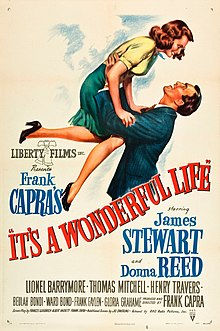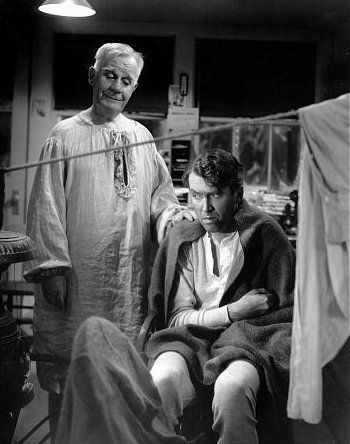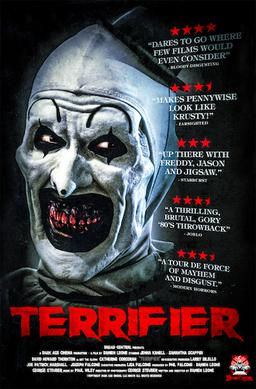It's a Wonderful Life (1946) review
- Jeremy Kelly
- Dec 23, 2021
- 5 min read
Updated: Dec 25, 2021
It’s a Wonderful Life (1946)
Directed by: Frank Capra
Produced by: Frank Capra
Screenplay by: Frances Goodrich, Albert Hackett, Frank Capra
Starring: James Stewart, Donna Reed, Lionel Barrymore, Thomas Mitchell, Henry Travers, Beulah Bondi, Ward Bond, Frank Faylen, Gloria Grahame

There was a time when most major Hollywood movies thrived on a positive, feel-good attitude; think about it, many 21st century critical big-hitters by names like David Fincher, Paul Thomas Anderson, and the Coen Brothers are likely to entertain you but not really leave a warm, fuzzy feeling inside. But let me tell you about a rags-to-riches story named Frank Capra, an Italian immigrant who directed some of the most popular movies of the 1930s; “It Happened One Night,” “You Can’t Take It with You,” and “Mr. Smith Goes to Washington” were all crowd and awards favorites, and are today regarded as classics. Then he gave it all up after the Japanese Attack on Pearl Harbor to enlist as a major in the U.S. Army; for the next four years, he was commissioned to helm a series of documentary films called “Why We Fight,” as a way of countering enemy propaganda. Then after World War II, he made one of the most beloved Christmas movies of all-time. Based on the Philip Van Doren Stern short story “The Greatest Gift,” today’s film is “It’s a Wonderful Life,” one that dances on the edge of over-sentimentalism but is so beautifully warm and emotional that I always buy into it.
The plot concerns George Bailey (James Stewart), an upstanding building and loan businessman who’s spent his life sacrificing his personal dreams and ambitions in order to help his friends and citizens in the quiet community of Bedford Falls, New York, which is mostly under control of the miserly baron Mr. Potter (Lionel Barrymore). George has many friends, a loving wife Mary (Donna Reed), and four children, but after giving up college, chances to travel, his honeymoon, practically any opportunity for a more successful life, and now facing a Christmas Eve financial crisis, he’s become depressed and despondent. On the brink of suicide, George then meets Clarence (Henry Travers), who claims to be his guardian angel. When he bitterly wishes he had never been born, Clarence shows him a reality where he never existed, and how it’s affected all the people in his life.
I don’t need to go in depth about the kind of actor James Stewart was; far from just having a distinct drawling voice, he was one of the premiere actors of the 20th century, routinely giving winning performances while often playing decent, idealistic types. What I appreciate is that George is not portrayed as a perfect man. Throughout the highlights of his life, we see him initially very big-eyed and optimistic; but he becomes jaded, temperamental, even hostile at times. However, it all balances out because we see just how hard he works and how much he wants to help people, yet always feels like he’s getting the short end of the stick. Most of us have heard the phrase “fake it ‘till you make it,” but we’re watching a man do this his entire life and feeling like his ship is never coming in.

Stewart’s displays of self-doubt and anxiety seem even more genuine given where he was in his personal life; much like Capra, this was his first film after the war, where he rose from the rank of private to colonel. At that time, he was uncertain about his acting abilities, given the up-and-coming talent, so it’s easy to empathize in scenes where he really breaks down, considering himself a failure. This was Stewart’s third collaboration with Capra, and he would indeed re-emerge in hits directed by Alfred Hitchcock, Anthony Mann and Henry Koster. So George’s personal arc is one we can understand, but it doesn’t have nearly as much of an impact if the supporting characters aren’t memorable, because we don’t feel the affect that his absence would have; thankfully, the movie’s full of easily likeable people, especially Donna Reed as Mary. It might seem like there isn’t much to the character other than she really loves George; but she’s very witty and proactive, often taking charge in dramatic situations. Reed sports a beautiful smile, and has impeccable chemistry with Stewart; apparently, their first kiss scene had to be cut down because it was so intense for censors at the time.
There’s also Henry Travers as the whimsical Clarence, character actor veteran Thomas Mitchell as George’s bumbling Uncle Billy, Ward Bond and Frank Faylen as his friends Bert and Ernie—by the way, their names apparently did not influence the creators of “Sesame Street” years later—Gloria Grahame as the flirtatious Violet, and of course, Jimmy the raven, who reportedly appeared in more than 1,000 films. But the one everybody absolutely loves to hate is Lionel Barrymore as Potter, who makes Ebenezer Scrooge look like the most generous man in the world. In fact, he was originally supposed to play Scrooge in the 1938 film adaptation of “A Christmas Carol,” but dropped out due to arthritis and was replaced by Reginald Owen; however, he would play him annually on radio for a 20-year period. Anyway, imagine Scrooge as the owner of a bank who told the Christmas Ghosts to screw off, and you get the idea. He’s a contemptible bastard, yet not overblown or unrealistic; he still has traces of a fleshed-out character, dry-witted and sardonic when he wants to be.

When this movie came out, some found it too sappy, or even a dangerous smear on capitalism in its portrayal of the Potter character. But here we are 75 years later, and it is staggering just how relevant some of these themes still are, the struggles people face just to earn a decent living, and the higher-ups who respond, “F*** you, pay me.” The alternate reality of Pottersville in place of Bedford Falls serves as a sobering reminder of how the modern world has become, full of cynicism and avarice. But ultimately, it’s more of a backdrop to the actual story, which is George’s personal redemption; watching him come to terms with this alternate timeline just sells the tragedy of the situation. It’s amazing the effect that one person can have on someone else’s life, and emphasizes that in the grand scheme of things, we all matter in ways that we can’t even begin to fathom. By the time it reaches the end where everyone’s gathering at the Bailey house, the momentum and weight of all these displays of love and gratitude just hits you so hard, just—oh! It brings tears to my eyes no matter how many times I watch it; and in Pennsylvania, they say, Jeremy’s small heart grew three sizes that day.
I adore this movie; there are moments that feel dated and awkward, but it doesn’t take me out of it at all. However, unlike most of Capra’s earlier efforts, “It’s a Wonderful Life” wasn’t much of a hit. It earned Oscar nominations, but while his initial films capitalized on viewers’ depression-era and pre-war optimism, this current America didn’t flock to such old-time good-heartedness; rather, they embraced the post-war drama “The Best Years of Our Lives,” which, admittedly, I love too. Then you had the advent of television, the rise of low-budget film noir, and the paranoia of the anticommunism “witch hunts” by the HUAC that stretched into the 1950s, a situation that affected this movie and Capra on a personal level; needless to say, it was a different time in the world of cinema. However, that’s another story for another day; in the ‘70s, the film slipped into the public domain for a while, and found new life through numerous holiday TV airings. Today, it’s a common Christmas staple, and for good reason; so if you’re ever feeling down about yourself, just remember that simply by being you, it can make someone else’s life better. Merry Christmas, everyone.
My rating: 10/10





Comments